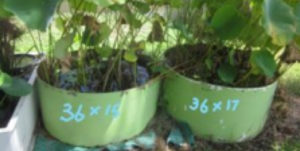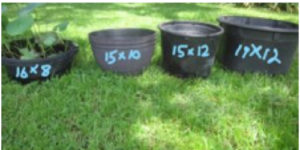How To Plant Nelumbo Lotus
TIP: If you just received a lotus tuber remove it from the packaging material and float it in non-chlorinated water until you can plant it. Alternatively, if it will be a while before you can plant it, put it into a sealed plastic bag (no water) and then into the vegetable drawer of a refrigerator for up to several weeks. The best time to plant is when the lotus tuber is dormant and the outside temperature is warm. March is usually a good time here in Florida when night time temperatures stay above 50 degrees.
Assemble Materials

Nelumbo Lotus Decorative Pots

Nelumbo Lotus Plain Pots
- Pots. Select a round pot without holes. A nursery pot or a decorative pot with straight sides is best. The diameter of the pot is determined by the size of the lotus
- Bowl lotus: 10″ wide and 6″ to 10″ deep
- Small or dwarf lotus: 14″ – 18″ wide and 7″ to 12″ deep
- Medium lotus: 16″ to 24″ wide and 8″ to 14″ deep
- Large/tall Lotus: 20″ and wider and 12″ to 24″ deep
- You may need to improvise on larger sizes like we did. In the photos above, the green pots are actually old aerator tanks we cut down and spray painted.
- Top soil. Not potting soil. The ideal soil will contain some clay but that’s not always available. Adding some potters clay works..
- Fertilizer. We like to use a 6 month slow release granular fertilizer with a 14-5-14 ratio. Another readily available slow release fertilizer is “Dynamite” in a red bottle with a 15-15-15 ratio. Too much nitrogen can burn the leaves. If the leaves turn yellow pour out the water and add more non-chlorinated water to dilute the nitrogen in the pot.
- A small piece of flagstone.
Planting Nelumbo Lotus – Step By Step
- Three inches of soil is all that is needed. If using pottery clay, mix it with the top soil.
- Add enough non-chlorinated water to make the soil mix moist, but not soupy. If you squeeze a handful of soil it should form a clump. It may take an hour or more for the soil to become evenly moist.
- If using slow release granular fertilizer, mix it into the soil now. Dynamite releases slowly for the first month allowing enough time for aerial leaves to form. For small lotus add about 2 tablespoons and for large ones 1/3 cup. This should take care of fertilizer for one season. If you notice few blooms and small leaves add a faster release fertilizer following the manufacturers directions. Stop fertilizing about the middle of August.
- Make a shallow trough in the soil, curved around the edge of the pot about the length of the tuber. The cut edge of the tuber should be against the edge of the pot.
- Put the small piece of flagstone over the tuber, but not at the node. Except for the small flagstone piece, do not cover the tuber with dirt or stones.
- Gently add non-chlorinated water to a depth of 3″. Check frequently and add water as needed. When the plant is bigger more water may be added.
- The pot should be placed in a sunny spot. Some like to put it into a pond but you may need to prop it up on bricks or cement blocks to maintain the water depth in the pot until the plant grows taller.
- The first sign of growth will be small leaves floating on the water. These are called ‘coin’ leaves. As the plant grows the leaves become aerial leaves. If not using slow release fertilizer, you may begin fertilizing when the plant has produced 4 to 5 of these leaves. MiracleGrow is one brand. Use one tablespoon added directly to the water in the lotus pot every three weeks.